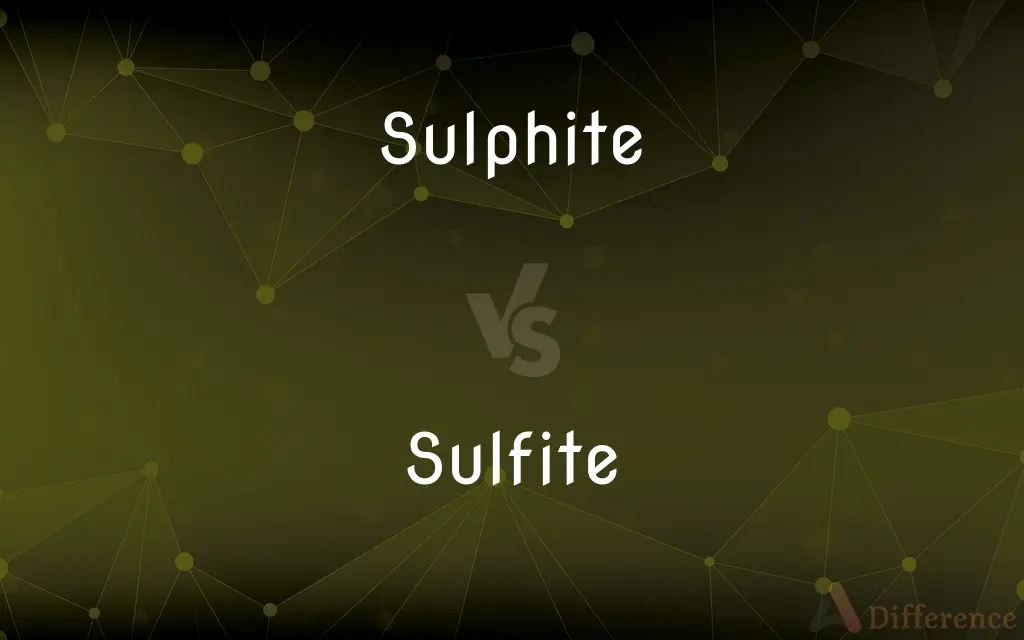Sulphite vs. Sulfite — What's the Difference?
By Tayyaba Rehman & Maham Liaqat — Updated on April 6, 2024
Sulphite and sulfite refer to the same chemical compound group, differing only in British and American spelling preferences.

Difference Between Sulphite and Sulfite
Table of Contents
ADVERTISEMENT
Key Differences
Sulphite is the British English spelling for a group of chemical compounds that contain the sulfite ion, SO3^2-. These compounds are widely used in the food and beverage industry as preservatives to prevent oxidation and maintain freshness. Whereas, sulfite is the American English spelling of the same term, reflecting the difference in language conventions rather than any variation in chemical structure or function. Both terms refer to the same chemical substances and their applications are identical across industries.
While the term sulphite is commonly used in countries following British English conventions, such as the UK, Australia, and Canada, sulfite is preferred in the United States. This distinction is purely orthographic and does not affect the scientific understanding or application of these compounds. On the other hand, in scientific literature and international standards, the usage can vary depending on the origin of the publication, but the context makes the meaning clear.
Sulphites or sulfites are known for their antioxidant properties, which make them valuable in preventing the browning of fresh food and the spoilage of wine. They are also employed in the production of pharmaceuticals and cosmetics, highlighting their versatility. The effectiveness of these compounds in preserving color and flavor while inhibiting microbial growth is crucial for the shelf-life and safety of many products.
The regulatory guidelines for sulphites/sulfites usage in foods and beverages are stringent, given their potential to cause allergic reactions in sensitive individuals. Regulations often require that products containing these compounds at levels above certain thresholds must declare their presence on labels. This is a key area where the spelling difference is negligible, as the focus is on the safety and transparency of their use in consumer products.
Despite their utility, sulphites/sulfites can pose health risks for some individuals, particularly those with asthma or sulphite sensitivities. It's important for consumers to be aware of these compounds in their food and beverage choices. This concern transcends the orthographic differences, emphasizing the importance of recognizing and understanding the presence of these compounds in everyday products.
ADVERTISEMENT
Comparison Chart
Spelling
Sulphite
Sulfite
Chemical Formula
SO3^2-
SO3^2-
Usage
Preservatives, antioxidants
Preservatives, antioxidants
Regulatory Concerns
Must be labeled if above certain levels
Must be labeled if above certain levels
Health Risks
Potential allergens, particularly for those with asthma or sensitivities
Potential allergens, particularly for those with asthma or sensitivities
Industries
Food and beverage, pharmaceuticals, cosmetics
Food and beverage, pharmaceuticals, cosmetics
Language Preference
UK, Australia, Canada
United States
Compare with Definitions
Sulphite
Must be declared on food labels in concentrations above certain levels.
Products containing more than 10ppm of sulphites must indicate their presence on the label.
Sulfite
Same as sulphite, but spelled according to American English conventions.
The FDA regulates sulfite use in foods and requires labeling for certain levels.
Sulphite
Chemical compounds that contain the sulfite ion, SO3^2-, used as preservatives and antioxidants.
The winemaker added sulphites to the wine to extend its shelf life.
Sulfite
Identical to sulphites, used as antioxidants and preservatives.
Sulfites in wine prevent microbial growth and oxidation.
Sulphite
In food and beverages to prevent oxidation and browning.
Sulphites are added to dried fruit to maintain its color and freshness.
Sulfite
Similar requirements for declaration on product labels.
US regulations mandate sulfite labeling on foods and beverages exceeding 10ppm.
Sulphite
Can trigger allergic reactions or asthma attacks in sensitive individuals.
Individuals with asthma may experience adverse reactions to foods containing sulphites.
Sulfite
Pose the same risks as sulphites, with potential for allergic reactions.
Sensitive individuals must avoid products with sulfites to prevent health issues.
Sulphite
Preferred in British English-speaking countries.
In the UK, food packaging lists sulphites as an ingredient.
Sulfite
Used in American English contexts.
American products label these compounds as sulfites.
Sulphite
Alternative spelling of sulfite
Sulfite
Sulfites or sulphites are compounds that contain the sulfite ion (or the sulfate(IV) ion, from its correct systematic name), SO2−3. The sulfite ion is the conjugate base of bisulfite.
Sulphite
(obsolete) A person who is spontaneous and original in thought and conversation.
Sulfite
The divalent anionic group SO3, derived from sulfurous acid, or a compound containing this group.
Sulphite
A salt of sulphurous acid; - called also sulfite.
Sulfite
Any salt of sulfurous acid.
Sulphite
A person who is spontaneous and original in his habits of thought and conversation.
A sulphite is a person who does his own thinking, he is a person who has surprises up his sleeve. He is explosive.
Common Curiosities
Is there a difference between sulphite and sulfite?
No, the difference is purely in spelling, with "sulphite" being British English and "sulfite" American English.
Can sulphites/sulfites cause allergic reactions?
Yes, they can trigger allergies or asthma attacks in sensitive individuals.
How can I identify sulphites/sulfites in food products?
Look for their presence on ingredient labels, especially in products like wine, dried fruits, and processed foods.
Can sulphites/sulfites be naturally occurring?
Yes, some food and beverages, like wine, can contain naturally occurring sulphites/sulfites.
Why are sulphites/sulfites added to food?
They prevent oxidation and spoilage, maintaining the color, freshness, and safety of food and beverages.
How are sulphites/sulfites regulated?
Regulatory bodies require products containing more than a certain level of sulphites/sulfites to declare them on labels.
What are sulphites/sulfites?
Chemical compounds containing the sulfite ion, used as preservatives and antioxidants in various industries.
Do sulphites/sulfites affect the taste of food and beverages?
Generally, they do not significantly alter the taste when used in approved concentrations.
What does the term "free of sulphites/sulfites" mean on a label?
It indicates that the product does not contain added sulphites/sulfites, though trace amounts might still be present.
Are there alternatives to sulphites/sulfites in food preservation?
Yes, alternatives include vitamin C (ascorbic acid), vitamin E (tocopherols), and others that also have antioxidant properties.
Are sulphites/sulfites only used in food?
No, they're also used in pharmaceuticals, cosmetics, and as industrial preservatives.
What is the recommended daily intake of sulphites/sulfites?
There's no specific recommended daily intake, but individuals sensitive to sulphites/sulfites should avoid them.
Why are sulphites/sulfites controversial?
Due to their potential health risks for sensitive individuals, leading to calls for reduced use and clearer labeling.
Share Your Discovery

Previous Comparison
Attributed vs. Attributable
Next Comparison
Bird vs. BeastAuthor Spotlight
Written by
Tayyaba RehmanTayyaba Rehman is a distinguished writer, currently serving as a primary contributor to askdifference.com. As a researcher in semantics and etymology, Tayyaba's passion for the complexity of languages and their distinctions has found a perfect home on the platform. Tayyaba delves into the intricacies of language, distinguishing between commonly confused words and phrases, thereby providing clarity for readers worldwide.
Co-written by
Maham Liaqat















































